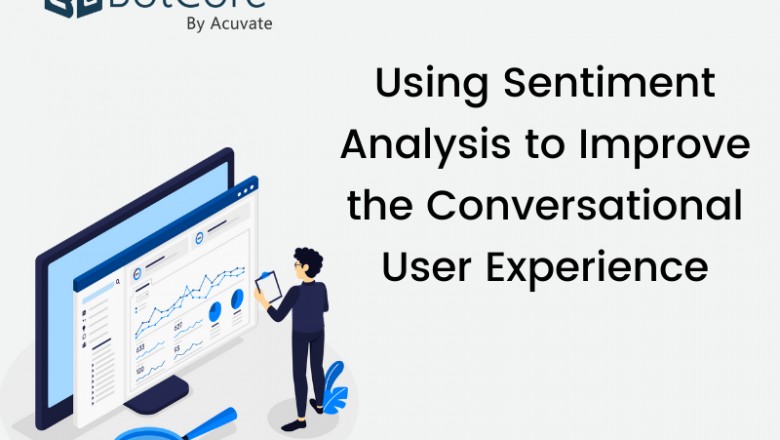views

Analysis firm Juniper Research predicts, “By 2022, chatbots could help trim business costs by more than $8 billion per year.”
The same study anticipates a significant surge in automated customer service programs as companies move to embrace artificial intelligence (AI) and predicts that in industries, which manage a large volume of human interaction, 75-90% of queries will be dealt with by chatbots, resulting in cost savings of up to $0.70 per interaction.
Indeed, AI has revolutionized how businesses interact with their customers. However, enterprises looking to replace, or at least augment, their traditional customer interactions with AI don’t want to lose the human touch.
Humans are emotional beings, and the ability to gauge sentiments and respond with empathy is ingrained in our language instincts. No wonder, during interactions with service chatbots, customers expect the bots to understand their tonality, mood, and sentiments and respond accordingly.
That is where sentiment analysis comes into the picture. This blog gives an insight into what sentiment analysis is and how it is used in chatbots to enhance the overall customer experience.
Sentiment analysis is a sub-category of natural language processing (NLP) and machine learning (ML) that extracts emotions, thoughts, and opinions from audio or textual data.
In short, sentiment analysis enables bots to comprehend the user’s mood and sentiments by analyzing utterances for words and phrases that indicate a particular emotion. The bot can then model its response suitably to provide excellent customer service. Using machine learning tools to train the bot with words/phrases that correlate to different moods, sentiment analysis teaches the bot to detect emotions without any human intervention.
For example, A customer writes, “I am annoyed with your team. I have been sent items that I didn’t order.”
The bot responds by saying, “We are incredibly sorry for the mistake. The correct package will be delivered today by 16:30 hours.
Here, sentiment analysis renders emotional intelligence to the bot and allows it to understand that the phrase annoyed is an expression of the customer’s disgust and anger at the callousness of the team.
Hence, sentiment analysis helps bots conduct thoughtful, engaging, and meaningful conversations with customers.
Here’s how the process flows –
One of the most significant benefits of sentiment analysis is its ability to decipher the customer’s mood and personalize responses to match the sentiment.
This helps the bot to create engaging customer interactions from the get-go, increasing chatbot adoption in the process.
Often standardized, scripted phrases, such as “Please wait” or “We will assist you shortly,” can evoke strong emotions and alter customer attitude.
Identifying such messages that brush customers the wrong way can help organizations change their service approach. Analyzing sentiment data enables bots to determine the kind of conversation flows that generate maximum customer satisfaction and improve the conversational user experience in the future.
Sentiment analysis empowers bots to gauge customer emotion early on in the chat, allowing them to invoke appropriate escalation and route the angriest/most frustrated users to the suitable human agents for more efficient support.
Seamless escalation to a live agent leads to a better conversational user experience. It is especially advantageous during peak hours when the customer support staff finds it challenging to handle hundreds of customers and comprehend individual emotions. Using sentiment analysis ensures human agents handle only the most critical requests.
Emotions play heavily in determining how a customer perceives your brand. Understanding how satisfied your customers are with your products and services will assist you in predicting the length and nature of their relationship with the brand.
Using sentiment analysis to comprehend how customers feel about your brand helps you communicate effectively and tailor experiences to improve brand perception.
Sentiment analysis presents insights that enable you to segment your customer base by how happy or dissatisfied your customers are with your brand.
Using this information, organizations can prioritize support for the unhappy users and design strong branding and product strategies for the future while rewarding the most loyal customers at the same time.
With sentiment analysis, bots can identify delighted customers and generate upsell and cross-selling opportunities by recommending new/complementary products.
By analyzing the sentiments of new users, the bot can suggest the right products and retain their interest in your brand.
At Acuvate, we help clients build AI-enabled chatbots with our enterprise bot-building platform called BotCore.
BotCore’s chatbots come with a built-in capability to perform sentiment analysis. With minimalistic coding requirements and a graphical design interface, our bots can be built and deployed within a few weeks.
Interestingly, our chatbots can uncover a myriad of emotions, including anger, joy, curiosity, frustration, disappointment, fear, sadness, and positivity, and even identify and score multiple emotions (Example, joy and mild disappointment) in a single user utterance.
Moreover, our bots leverage the best of Microsoft’s machine learning, AI, and natural language processing technologies to understand user context, rank customer emotions at the individual and aggregate level (i.e., for the entire chat), identify vital emotional triggers, curate appropriate responses, and seamlessly hand over the conversation to a human agent when needed.
Additionally, our bots support multiple languages, such as French, Italian, English, German, etc.
To know more about BotCore and its sentiment analysis functionality, please feel free to schedule a personalized consultation with our experts.
Get in touch with our experts
Abhishek brings with him 12+ years of strong expertise across the Microsoft stack. He has consulted with clients globally to provide solutions on technologies such as SharePoint, Office 365, Azure, System Center and Enterprise Mobile platforms. He has worked with clients across multiple industry domains including BFSI, FMCG, Manufacturing, and Telecom.












